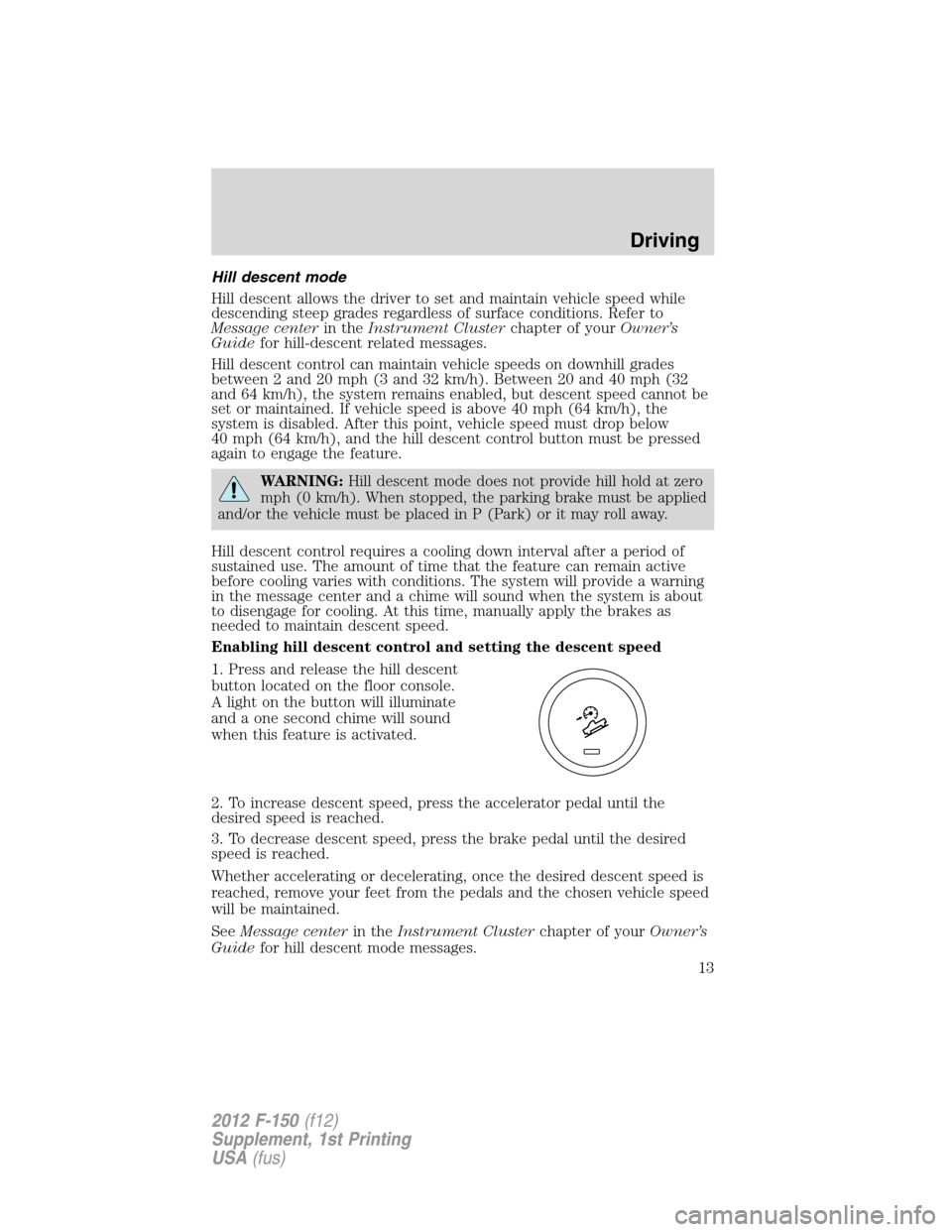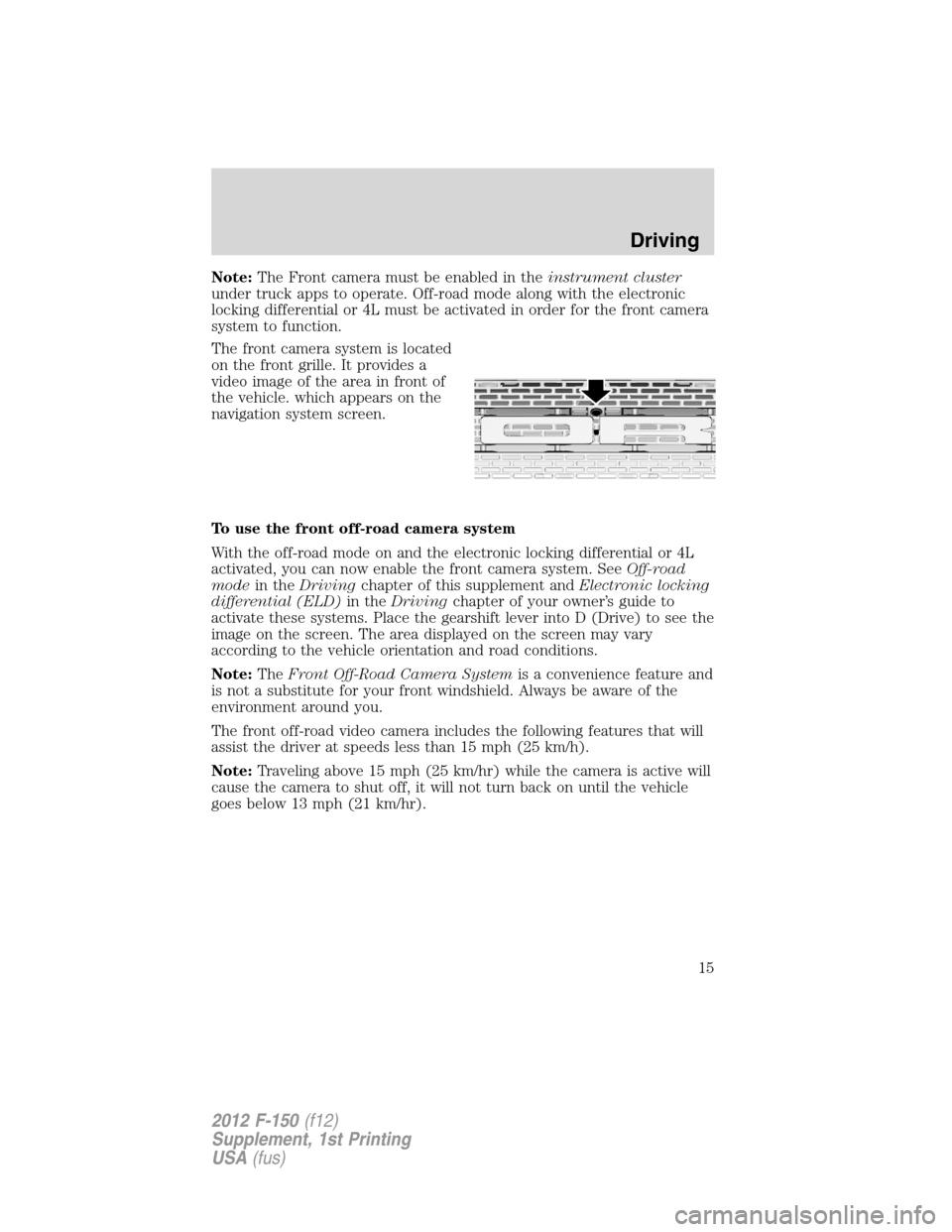Page 5 of 36

•Front fenders with functional air extractors
•Seats with increased bolstering and unique covers
•Front and rear LED marker lamps
•Switch pack with “off-road mode” and “hill descent” buttons, and four
auxiliary switches
•Longer, cast aluminum lower control arms
•Longer, forged steel upper control arms
•Front coil springs and rear leaf springs
•Fox Racing 47 mm piston internal bypass front shocks
•Fox Racing 47 mm pistons, internal bypass, remote reservoir rear
shocks
•Micro-cellular urethane jounce bumpers (front and rear)
•Raptor navigation welcome screen
•17” cast aluminum wheels and 315/70-17 BFGoodrich�all-terrain tires
•Full-size all-terrain spare tire
•Off-road specific calibrations for engine, transmission and
AdvanceTrac�system
•Instrument panel cluster graphics
•High line LCD cluster with unique SVT off-road screen
•Steering wheel - unique wrap with on-center marker, thumb pads, and
improved grip contour
F-150 SVT Raptor-specific features
5
2012 F-150(f12)
Supplement, 1st Printing
USA(fus)
Page 13 of 36

Hill descent mode
Hill descent allows the driver to set and maintain vehicle speed while
descending steep grades regardless of surface conditions. Refer to
Message centerin theInstrument Clusterchapter of yourOwner’s
Guidefor hill-descent related messages.
Hill descent control can maintain vehicle speeds on downhill grades
between 2 and 20 mph (3 and 32 km/h). Between 20 and 40 mph (32
and 64 km/h), the system remains enabled, but descent speed cannot be
set or maintained. If vehicle speed is above 40 mph (64 km/h), the
system is disabled. After this point, vehicle speed must drop below
40 mph (64 km/h), and the hill descent control button must be pressed
again to engage the feature.
WARNING:Hill descent mode does not provide hill hold at zero
mph (0 km/h). When stopped, the parking brake must be applied
and/or the vehicle must be placed in P (Park) or it may roll away.
Hill descent control requires a cooling down interval after a period of
sustained use. The amount of time that the feature can remain active
before cooling varies with conditions. The system will provide a warning
in the message center and a chime will sound when the system is about
to disengage for cooling. At this time, manually apply the brakes as
needed to maintain descent speed.
Enabling hill descent control and setting the descent speed
1. Press and release the hill descent
button located on the floor console.
A light on the button will illuminate
and a one second chime will sound
when this feature is activated.
2. To increase descent speed, press the accelerator pedal until the
desired speed is reached.
3. To decrease descent speed, press the brake pedal until the desired
speed is reached.
Whether accelerating or decelerating, once the desired descent speed is
reached, remove your feet from the pedals and the chosen vehicle speed
will be maintained.
SeeMessage centerin theInstrument Clusterchapter of yourOwner’s
Guidefor hill descent mode messages.
Driving
13
2012 F-150(f12)
Supplement, 1st Printing
USA(fus)
Page 15 of 36

Note:The Front camera must be enabled in theinstrument cluster
under truck apps to operate. Off-road mode along with the electronic
locking differential or 4L must be activated in order for the front camera
system to function.
The front camera system is located
on the front grille. It provides a
video image of the area in front of
the vehicle. which appears on the
navigation system screen.
To use the front off-road camera system
With the off-road mode on and the electronic locking differential or 4L
activated, you can now enable the front camera system. SeeOff-road
modein theDrivingchapter of this supplement andElectronic locking
differential (ELD)in theDrivingchapter of your owner’s guide to
activate these systems. Place the gearshift lever into D (Drive) to see the
image on the screen. The area displayed on the screen may vary
according to the vehicle orientation and road conditions.
Note:TheFront Off-Road Camera Systemis a convenience feature and
is not a substitute for your front windshield. Always be aware of the
environment around you.
The front off-road video camera includes the following features that will
assist the driver at speeds less than 15 mph (25 km/h).
Note:Traveling above 15 mph (25 km/hr) while the camera is active will
cause the camera to shut off, it will not turn back on until the vehicle
goes below 13 mph (21 km/hr).
Driving
15
2012 F-150(f12)
Supplement, 1st Printing
USA(fus)
Page 19 of 36

WARNING:Off-roading can be extremely dangerous and carries
inherent risks that may not be preventable even with the best
precautions. Ford strongly recommends driving within your ability and
taking every safety precaution, including those found here and at other
off-road driving organizations such as the Best in the Desert Racing
(www.bitd.com) and SCORE International Off-Road Racing.
Off-road screen
The real-time status of the Raptor’s off-road systems can be continuously
monitored using the first off-road screen found under the Truck Apps
menu in the message center.
SeeMessage centerin theInstrument Clusterchapter of your Owner’s
Guide for more information.
Basic off-road driving techniques
•Grip the steering wheel with thumbs on the outside of the rim. This
will reduce the risk of injury due to abrupt steering wheel motions
that occur when negotiating rough terrain. Do not grip the steering
wheel with thumbs inside the rim.
•Throttle, brake and steering inputs should be made in a smooth and
controlled manner. Sudden inputs to the controls can cause loss of
traction or “upset” the vehicle, especially while on sloped terrain or
while crossing obstacles such as rocks or logs.
•Look ahead on your route noting upcoming obstacles, surface texture
or color changes or any other factors which may indicate a change in
available traction, and adjust the vehicle speed and route accordingly.
During pre-run, mark obstacles with GPS markers to ensure
appropriate speeds are used to avoid potential vehicle damage.
•When driving off-road, if the front or rear suspension is bottoming-out
and/or excessive contact with the skid-plates is encountered, reduce
vehicle speed to avoid potential damage to the vehicle.
•When running with other vehicles, it is recommended that
communication is used, and the lead vehicle notify other vehicles of
obstacles that could cause potential vehicle damage.
•Always keep available ground clearance in mind and pick a route that
minimizes the risk of catching the underside of the vehicle on an
obstacle.
Driving
19
2012 F-150(f12)
Supplement, 1st Printing
USA(fus)